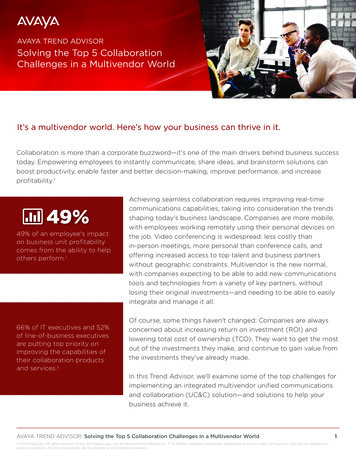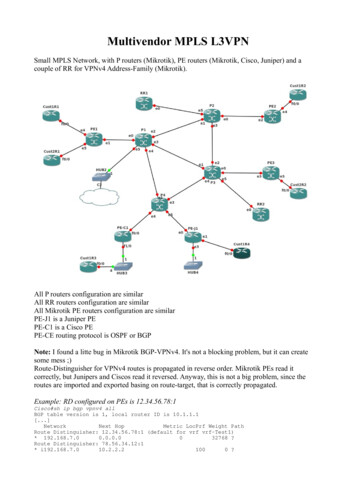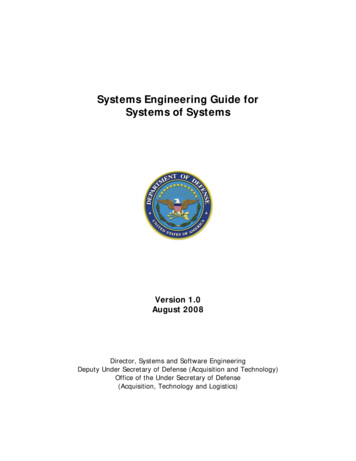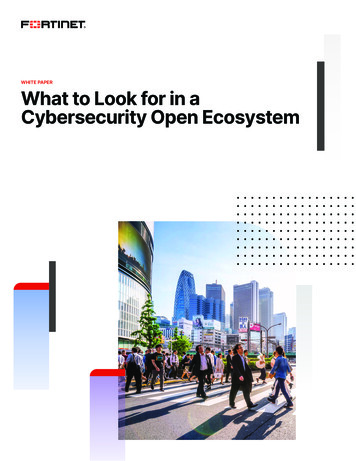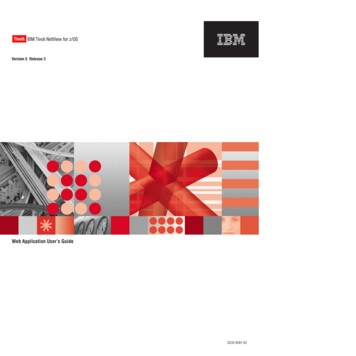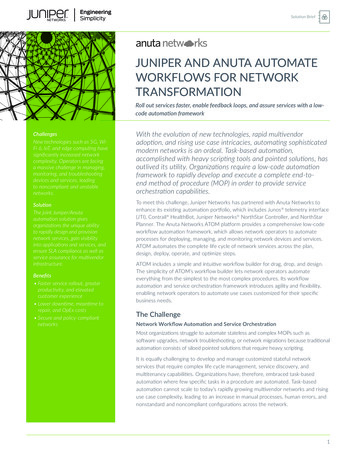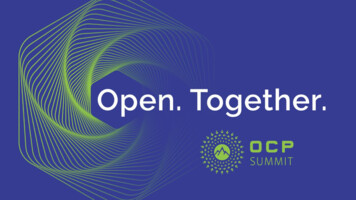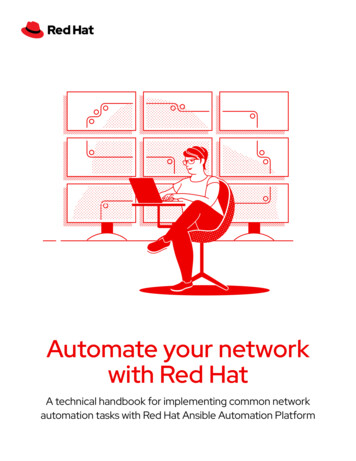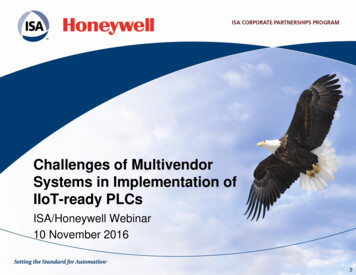
Transcription
Challenges of MultivendorSystems in Implementation ofIIoT-ready PLCsISA/Honeywell Webinar10 November 20162
Before we begin: Challenges of Multivendor Systemsin Implementation of IIoT-ready PLCs Listen online OR call-in:– Call-in toll-free number: 1-866-657-0092 (US)– Call-in number: 1-832-445-3182 (International)– Conference Code: 682 284 3439 We start at11 am ETTo listen through your computer, enable the Audio Broadcast:– Click on Communicate at the top of your WebEx screen then clickAudio Broadcast Your line will be MUTED– If you have a question for the host, please use the WebEx Chat Toolon the right-hand side of your screen. Please do not use the Q&A boxfor miscellaneous questions. The Q&A chat box is reserved only for ourQ&A sessions during the webinar.If you are experiencing any technical difficulties, please contact our Customer Service Specialistsat (919) 549-8411 OR go to https://isa2.webex.com/isa2/mc and on the left navigation bar, click"Support".1
Poll Questions Questions & Answers There will be four (4) Poll Questions Enter answers into the Poll Feature on the right-hand sideof your WebEx window. There will be one (1) Q&A Session Enter questions into the Q&A box on the right-hand side ofyour WebEx window. Unfortunately, with this many attendees, we cannot open upthe phones for questions.3
Graham Nasby Water SCADA & Security Specialist for alarge publicly-owned water utility in NorthAmerica.Responsible for the capital planning and dayto day operation of the utility's geographicallydisbursed automatic control systems.Extensive experience with the design andoperation of industrial control systems,including both PLC/SCADA and DCSsystems.Voting member of the ISA-18.2 alarmmanagement committee and a CertifiedFunctional Safety Engineer (SafetyInstrumented Systems).5
Andrew Brodie Global Control Offerings Marketing Leader,Honeywell Process Solutions20 years of hands-on process automationexperience spanning several disciplinesincluding engineering, business development,sales, product management, and productmarketing.He has industry knowledge from oil and gasproduction, pharmaceutical manufacturing,power generation, and discretemanufacturing.Andrew holds undergraduate degrees inIndustrial Instrumentation Technologyand Business Information Systems plusan MBA in Technology Management.4
Poll Questions1. Are you currently using a DCS integrated to PLCs?– A. Yes– B. No2. Have you ever integrated a DCS with a PLC?– A. Yes– B. No3. Have you participated in any applications of IIoT technology?– A. Yes– B. No4. Does your company have a position or strategy on IIoTtechnology adoption?– A. Yes– B. No– C. Uncertain6
AgendaI. IntroductionsII. Pros & Cons of Integrated Solutions for PLC/DCS systemsIII. Connecting IIoT Devices to PLC & DCS SystemsIV. Overview of Opportunities with IIoT integrationV. Q&A SessionVI. Conclusion7
Pros & Cons of Integrated Solutionsfor PLC & DCS-based IndustrialControl Systems8
Presentation Outline OverviewAnatomy of a Modern Control SystemTraditional PLC & DCS SystemsCommon Integration Challenges I/O and Device Level CommunicationsControllers & Controller ProgrammingProcess Control NetworkData Servers: Setup and Configuration HMI Screens & AlarmsBringing Process Data into Corporate/IT SystemsHow does IIoT fit into this?Opportunities for IIoT: Making Integration Easier9
Industrial Control Systems Field Equipment (Sensors, Transmitters, Pumps, Valves, etc.)Field Wiring – hardwired I/O & Fieldbus PLCs, PACs, RTUs, Controllers, etc. / Interface EquipmentControl System NetworksServersOperator View Stations Data TagsProcess DisplaysAlarm System / call-out systemsHistorianReporting10
Traditional PLC/SCADA SystemOther SystemsView NodesSCADA ServersProcess NetworkHistorianI/O ServerPLCsField WiringInstruments& Devices11
Traditional DCS SystemOther SystemsOperator TerminalsEngineering WorkstationDCS Servers & HistorianProcess NetworkControllersField WiringInstruments& Devices12
Modern Control System Layers View Terminals (HMI)Server Components–––––Application Servers (Screens)Alarm SystemCall-out Alarm System (if applicable)HistorianTrend/Reporting System I/O ServersProcess Network Programmable Controllers (PLCs, RTUs, RTACs, etc.)I/O CardsField WiringDevice Level (Transmitters, Drives, Valves, etc.)13
I/O and Device-Level Communications Hardwired I/O– Digital Inputs/Outputs – Voltage, Contact Type, Sink/Source, etc.– Analog Inputs/Outputs – Voltage, Current, Other Fieldbus I/O– Profibus– Foundation Fieldbus– DeviceNet Network Connectivity– Ethernet– Modbus, Ethernet/IP, ProfiNet, etc. Integration Tasks– Selecting I/O Types, Configuring I/O Cards, Programming, Scaling, Setup14
Controllers & Controller Programming PLC Systems––––– Separate programming environment from HMIMay be “tag-based” or “memory register based”Some systems support function blocks/templatesEasy to customize – just write more code!Labor-intensive to programDCS Systems– Integrated development environment with HMI– Reusable modules for common tasks– Sometimes customization can be tricky Hybrid Systems15
Process Control Network PLC Systems–––– Router configurationsFirewallsAssigning & managing IP addressesHow to Manage Configuration/ChangeDCS Systems– Often have network management tools Integrated DCS Systems– Turn-key network system: “Lego Bricks”16
Data Servers – Setup/Configuration Bringing data into the control systemControl systems talk to field devices using “data tags” PLC/SCADA Systems– Data server needs to connect to each PLC– Often separate “tag database” to translate PLC tags to server– If multiple PLCs, multiple drivers/configurations needed DCS Systems– Typically little to no setup, as this is handled at the controller level Non-Standard Devices– May require special drivers/programming to connect data17
HMI Screens & Programming/Deployment Operators use the HMI to interact with the control system PLC/SCADA Systems––––– Typically programmed separately from PLCsSeparate programming environmentUsually use Tag Database that is on the Data ServersMay be able to talk to PLCs directly, but usually notAmount of custom programming varies by systemDCS Systems– Integrated development environment– Usually has built-in “toolkit” reduce programming18
Alarm System Generates “Alarms” to interrupt operator so they can actionAlarms alert the operator to conditions requiring a response Alarm Trigger Conditions–––– Base Alarm ConditionAlarm LogicFilters: On/Off-Delay, Deadband, Plant State, etc.Alarm Routing to right OperatorPLC & DCS Systems––––Some have built-in alarm systems, others need add-on softwareSome systems have alarm routing and call-out capability built-inCan be time consuming to setup and configureAlarm Management software tools can help19
Data Connectivity to Corporate/IT Systems Control Systems to do not run in isolation! Connectivity to remote systems is now a requirement–––––––– Reporting SystemsERPProcess SchedulingBilling/Ordering SystemsAccounting SystemsMaintenance Management SystemsEnergy Management SystemsEtc.Many different protocols/methodsSecurity between levels important20
Pros/Cons of Traditional PLC Systems Pros– Hardware is usually less expensive– Very customizable, but lots of low level programming usually needed Cons–––––Significantly more programming effort requiredTraditionally limited support for modules/templates/function blocksLow level programming is needed for many functionsWhen integrating with the HMI, often two sets of tag databases are neededData Tag naming conventions can be inflexible21
Pros/Cons of Traditional DCS Systems Pros––––Integrated development environmentLots of templates and reusable modulesNot much custom programming neededRapid programming– Configuration management tools for devicesand instrumentation– More troubleshooting tools Cons– Traditionally more expensive to install– Can sometimes be hard to customize22
Connecting IIoT Devices . IIoT Industrial Internet of Things IIoT Opportunities– Newly available detailed monitoring & control– Much more data and status information available IIoT Challenges– IIoT devices typically have non-traditional communication interfaces– Writing “device driver/connector” code can be difficult/time-consuming– Many PLC & DCS Systems don’t know how to handle IIoT data To successfully use IIoT devices, you need control systems that cansupport the communication interfaces/types that IIoT devices haveIntegrating IIoT into a PLC/DCS is easier with IIoT toolkits & modules 23
24IntroductionIndustrial Internet of Things (IIoT)Broad range of potential usesSignificant development inautomation systemsProactive remoteasset health monitoringLeveraging datafrom dispersed enterprisesImprovedcollaborationFaster configurationand commissioning24
25Benefits & Concerns of Implementing IIoTcapable PLCsSpecific Benefits Enabling businesses to leverage vast amounts of data Providing operations personnel with improved remotemonitoring, diagnostic and asset managementcapabilities Enhancing data collection even in the most dispersedenterprises Improving decisions about the actual health of assets Reducing the time and effort for configuration andcommissioning Minimizing the need to troubleshoot device issues inthe field Bringing new production fields online faster, and Improving collaboration across the company.ConcernsSafety and securityConnectivityCompatibility withexisting networktechnologies/devices25
26Next Generation of Controllers Utilizing IIoT Optimize operations andmaintenance Open system benefits OPC UA open communication Multi-level and multi-platform IIoT-ready for cloud applications Investment protection Easier maintenanceCulmination of the Promise of Open Systems26
27Multi-vendor Challenges to ImplementationChallenges: Communication problems and errors Coordination and speed ofimplementation Amount of hardware and trainingConclusion: Reliability and integration can beincreased using a single vendor One vendor can provide both DCSand PLC expertise Benefits result in reducedimplementation cost and riskCombined PLC/DCS Solution Reduces Implementation Risk and Cost27
Project Engineering and Configuration Remote configuration and devicemonitoring Integrated HMI with a common view Universal I/O enables:- Late configuration & flexible design- Standardized cabinets- Reduced spares- Eliminated marshalling- Reduced footprintLower Infrastructure Cost28
29Increasing Operator Effectiveness Leaner control room Common HMI for DCS and PLC Fewer stations, less hardware, lesslicensing and training Smaller footprint, easiermaintenance Reduced cost over lifecycleIncreasing Efficiency Reduces Cost29
Collaboration and the Dispersed Enterprise Distribute information to the rightpeople Enable a dispersed workforce Remote access to real-time,contextual data Decentralize decision-makingMore Collaborative Decision-Making30
Cyber Security Embedded in PLC and DCS Secure boot Built-in firewall Certified secure developmentlifecycleRobust and Integrated Security31
32Combined PLC / DCS Solution: Ultimate Benefits Minimized troubleshooting Early startup Remote diagnostics and healthmonitoring Long-term efficienciesManufacturer Integration between PLC and DCS Reduces Risk and Cost32
33Benefits of IIoT-enabled Technologies33
Final Thoughts Control Systems are Layered - all the layers need to talk to each otherIIoT Devices represent another “layer” in industrial control systems PLC, DCS and Hybrid systems all have individual Pros & ConsTo pick best system for you, consider requirements & effort to maintain it When deploying a PLC or DCS system that will be using IIoT devices, itis usually preferable to have develop a system that provides theconnectivity that these systems need – as part one complete package There are many PLC/DCS Systems availablePick the one that fits your specific needs andkeep in mind effort needed to build/maintain it34
Any Questions? Enter questions into the Q&A box onthe right-hand side of your WebExwindow. Unfortunately, with this many attendees,we cannot open up the phones forquestions. If we miss your question or you wouldlike to discuss a topic in more depth withone of the presenters, feel free tocontact them directly.– Andrew Brodie: Andrew.Brodie@Honeywell.com– Graham Nasby: graham.nasby@grahamnasby.com35
Goodbye We thank you for attending Challenges of MultivendorSystems in Implementation of IIoT-ready PLCs We sincerely hope you acquired useful information We would very much like to see you again in one of our webseminarsPlease have a good day and a better weekAll registrants will receive an email with the webinar recording link, as well asadditional links for supporting information36
Before we begin: Challenges of Multivendor Systems in Implementation of IIoT-ready PLCs Listen online OR call-in: - Call-in toll-free number: 1-866-657-0092 (US) - Call-in number: 1-832-445-3182 (International) - Conference Code: 682 284 3439 To listen through your computer, enable the Audio Broadcast: - Click on Communicate at the top of your WebEx screen then click
